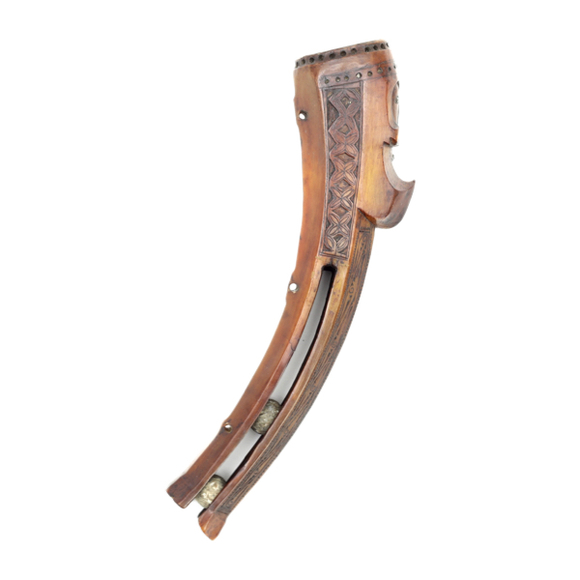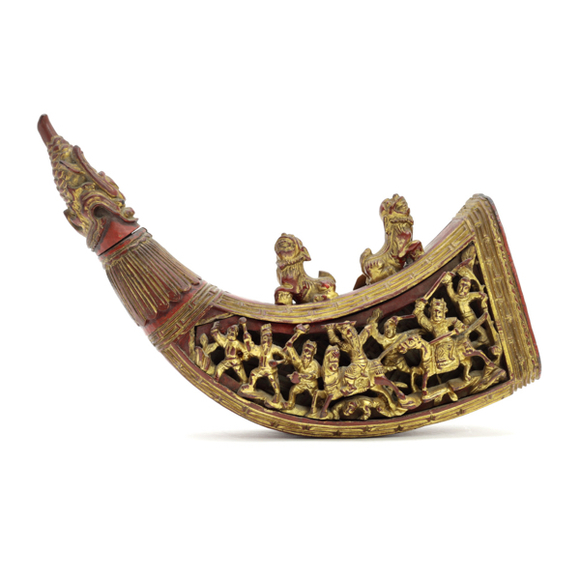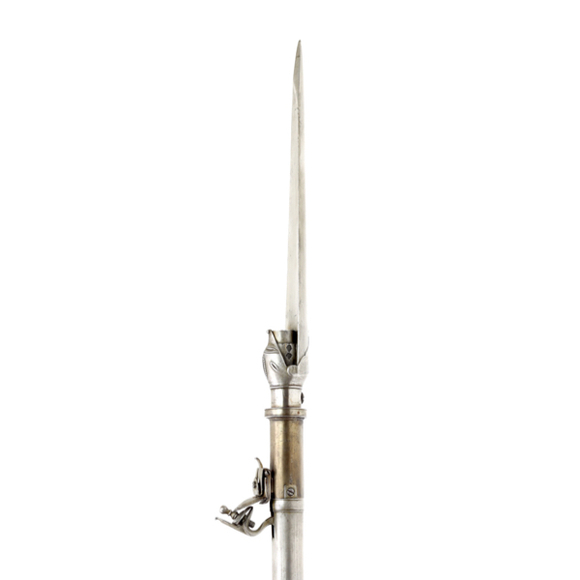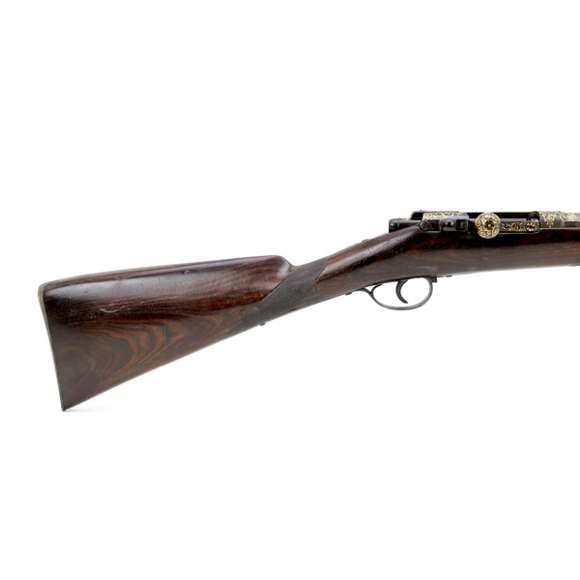With a golden damascened lock of the Indo-Portuguese type.

145 cm
114 cm
14 mm
2237 grams
Iron, steel, wood, brass, báitóng, silver, deer antler, elephant ivory.
Introduction
The Vietnamese matchlock musket is called súng hỏa mai in Vietnam. The lock is typically of the Indo-Portuguese type which operates with a springed serpentine that snaps down at the pull of the trigger.
Typical for South Vietnam are the short, slightly downward curving butt ends usually plated with bone, or in this case antler and ivory. They are meant to be held against the cheek instead of the shoulder. Recoil on old black powder was not as severe as on modern gunpowder, so the arms sufficed to absorb the recoil.
Description
A rather nice example of a súng hỏa mai with a quality smoothbore barrel of octagonal cross-section that flares out at the muzzle. At the breech side it is held in the stock by means of a screw that goes into the stock from the bottom, serving the double purpose of holding one end of the trigger guard. In addition, five silver bands secure it to the stock.
The long, elegant stock is made from a single piece of heavy ironwood. The but has antler plates at the top and bottom and a deeply patinated ivory plate on the very end. Each plate shows decolorations from the metal nails that hold it, attesting to their considerable age.
On top of the stock, above the lock, are a series of brass nails. They probably once held an ornamental plate, now gone. At the muzzle end of the stock is a silver protective plate that is engraved with Vietnamese floral motifs.
The lock is made entirely of báitóng (白銅), a prized Chinese alloy of copper, nickel, and zinc that was initially found in Yunnan. Ingots were sold by the Chinese since at least 1597. During the Qing, the export of the prized material was forbidden but was nevertheless smuggled plenty through maritime trade. In the 18th century, European metallurgists found out how to produce it artificially, after which it became known and traded as "German silver". Some collectors erroneously think "German silver" means "late" but this is inaccurate.
The lock follows the typical form for these, with a long lockplate with a very decorative profile that is secured to the stock by means of two bolts that go all the way through. On the other side, the stock is protected from the compression of the bolt heads by means of flower-shaped silver washers.
The trigger plate is similarly ornate in execution, with a nicely formed, sturdy trigger guard with stylized cloud decoration and a well-defined center ridge.
Condition
This is one of the best condition súng hỏa mai I have seen to date. It is complete, with all original parts save for the ramrod and a decorative plate at the top. Judging from the patina, this plate has been gone a very long time already. The barrel is in as good a condition as these get, with the local humid climate few survived so well. The stock has some of the usual dings from use but is without any major losses. No cracks in the wood. The ivory pommel plate is split. The lock is in good working order.
Attribution / dating
Vietnamese matchlock muskets can be divided into two main groups: Northern and southern styles. This piece, with the very short butt, is typical for what used to be Cochinchina. Those in the North, associated with the kingdom of Tonkin, has much longer stocks.
There are two Tonkinese guns with the long stock in the Rijksmuseum collection that once belonged to naval admiral Cornelis Tromp, sent to him by a friend from Batavia in 1679. See accession numbera NG-NM-6091 and NG-NM-6091-A They exhibit some design features that are very similar to ours, showing how far back some of these elements go.
We have a short account on Vietnamese gun production in Cochinchina from the acclaimed 18th-century Vietnamese philosopher, poet, encyclopedist, and government official Lê Qúy Đôn, dating from 1776:
"...the gun's nails are forged by blacksmiths, triggers and locks crafted by silversmiths... ...the stock carved by carpenters, the military's responsibility is making the barrels." 1
I've had a súng hỏa mai before with an all silver lock, which was executed in exactly the same style as this example, suggesting these silversmiths may at some occasion have also used báitóng for their locks.
During the reign of emperor Gia Long (ruled 1802-1820), many Vietnamese troops started to train with Western equipment and tactics, and by 1812 period observers noted that matchlocks had become a very rare sight. 2
It is probably safe to say it was most likely made between around 1750-1800.
Conclusion
Vietnamese matchlocks in any condition are quite rare. This particular piece is rare in both its very good state of preservation and the fact it has a very nicely made lock in a then exotic and expensive material.
NOTES
1. Lê Qúy Đôn, Phủ Biên Tạp Lục (撫邊雜錄 or "Miscellaneous Chronicles of the Pacified Frontier"), page 418. Thanks to Dong Nguyen for bringing this reference to my attention and kindly translating it for me. He runs the blog: Đại Việt Cổ Phong about Vietnamese history and traditional culture.
2. Observed by French missionary Pierre-Jacques Lemonnier de La Bissachère, quoted in Ian Heath; Armies of the Nineteenth Century, Asia 4, Burma and Indo-China. Foundry, Nottingham, 2003. Page 190.
CITES
To meet the demands of the Convention International Trade of Endangered Species (CITES), this object is sold with an appraisal document from a certified Dutch appraiser of the TMV Federation. Among others, it states that: The item is manufactured in the 18th century. The stock is of casuarina equisetifolia wood (non CITES listed) and has a buttplate of elephant ivory of the species elephas maximus (CITES appendix II).
The item is within article 2 of council regulation EC NO338/97 and within Convention of International Trade of Endangered Species (CITES): The materials were removed from the wild and significantly altered from their natural state well before the date of convention: June 1st, 1947. It can be freely traded within the EU without a permit, and is eligible for CITES export permit for trade outside of the EU.*
*Buyers outside of Europe: Beware that it may not be possible to export the item to your country due to restrictions on international ivory trade. CITES sets the minimal restrictions, countries and states under the convention often maintain further restrictions on top of CITES.













A what? Yes exactly. An extremely rare piece, the only example I am aware of in published collections at…
Based on the Dutch Beaumont mechanism, but with Indonesian twist forged barrel and golden inlays.






